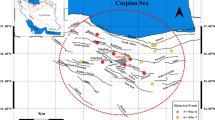Abstract
A relative in-depth review of current earthquake loss estimation software packages are given and compared in this paper. A simple and user-friendly tool for quick seismic risk assessment has been developed for Indian condition using spectrum-based, micro-level-based ground motion attenuation relation. The attenuation relation used here defines a suitable hazard scenario with moment magnitude and location of the earthquake as parameters. A comparison of losses using the proposed software with other open-source software tools has been carried using two case studies situated at different location of India, covering different building typologies. It is observed that the losses estimated by the proposed tool found to be less than the losses estimated by other two tools based on macroseismic intensity and PGA approach. The variation in the loss estimates results mainly from the lack of correlation between the different definitions of seismic hazard and different vulnerability models.





Similar content being viewed by others
References
Akkar S, Bommer JJ (2007) Prediction of elastic displacement response spectra in Europe and the Middle East. Earthq Eng Struct Dyn 36:1275–3010
ASCE-41 (2007) Seismic rehabilitation of existing buildings (ASCE/SEI 41-06). American Society of Civil Engineers Reston, Virginia
ATC-40 (1996) Seismic evaluation and retrofit of concrete buildings (ATC-40), vol 1. Applied Technology Council, Redwood City
Bozorgnia Y, Hachem MM, Campbell KW (2010) Deterministic and probabilistic predictions of yield strength and inelastic displacement spectra. Earthq Spectra 26:25–40
Campbell KW (1981) Near-source attenuation of peak horizontal acceleration. Bull Seism Soc Am 71(6):2039–2070
Cardona OD, Ordaz MG, Reinoso E, Yamin LE, Barbat AH (2010) Comprehensive approach for probabilistic risk assessment (CAPRA): international initiative for disaster risk management effectiveness. In: 14th European conference on earthquake engineering, Ohrid, Macedonia
Crowley H, Pinho R, Bommer JJ (2004) A probabilistic displacement-based vulnerability assessment procedure for earthquake loss estimation. Bull Earthq Eng 2:173–219
FEMA-273 (1997) NEHRP guidelines for the seismic rehabilitation of buildings. Federal Emergency Management Agency, Washington, DC
Fukushima Y, Tanaka T (1990) A new attenuation relation for peak horizontal acceleration of strong earthquake ground motion in Japan. Bull Seism Soc Am 80(4):757–783
Haldar P, Singh Y, Lang DH, Paul DK (2010) IVARA—A tool for seismic vulnerability and risk assessment of Indian housing. 14 SEE, IIT Roorkee, Uttarakhand, India
Haldar Putul, YogendraSingh Dominik H, Lang DK Paul (2013) Comparison of seismic risk assessment based on macroseismic intensity and spectrum approaches using SeisVARA. Soil Dyn Earthq Eng 2013:267–281
HAZUS-MH MR2 (2006) Multi-hazard loss estimation methodology. Earthquake model. Federal Emergency Management Agency, Washington, DC
IS 1893 (2002) Criteria for earthquake resistant design of structures (part-1). Bureau of Indian Standards, New Delhi
Jaiswal K, Wald DJ (2008) Creating a global building inventory for earthquake loss assessment and risk management. In: U.S. Geological Survey, p 103
Joyner WB, Boore DM (1981) Peak horizontal acceleration and velocity from strong-motion records including records from the 1979 Imperial Valley, California, earthquake. Bull Seismol Soc Am 71(6):2011–2038
Kappos AJ, Panagopoulos G, Panagiotopoulos C, Penelis G (2006) A hybrid method for the vulnerability assessment of R/C and URM buildings. Bull Earthq Eng 4:391–413
Kudo T, Tanaka T, Furumoto M (2009) Estimation of the maximum earthquake magnitude from the geothermal gradient. Seismological Society of America, San Francisco, California
Lang DH, Singh Y, Prasad JSR (2012) Comparing empirical and analytical estimates of earthquake loss assessment studies for the city of Dehradun, India. Earthq Spectra 28:595–619
Molina S, Lang DH, Lindholm CD (2010) SELENA—an open-source tool for seismic risk and loss assessment using a logic tree computation procedure. Comput Geosci 2010:257–269
NDMA (2010). Development of probabilistic seismic hazard map of India, A technical report by the Working Committee of Experts (WCE) constituted by the National Disaster Management Authority Govt. of India, New Delhi. Down loaded from http://www.hpsdma.nic.in/Development%20of%20Probablistic%20Seismic%20Hazard%20Map%20of%20India.pdf. 1st April, 2015
Newmark NM (1959) A method of computation for structural dynamics. J Eng Mech Divi ASCE 85(EM3):67–94
RADIUS (1999) Risk assessment tools for diagnosis of urban areas against seismic disasters. United Nations Office for Disaster Risk Reduction, Geneva
Rupakhety R, Sigbjornsson R (2009) Ground-motion prediction equations (GMPEs) for inelastic displacement and ductility demands of constant strength SDOF systems. Bull Earthq Eng 7:661–679
Sinha R, Adarsh N (1999) A postulated earthquake damage scenario for Mumbai. ISET J Earthq Technol 36(2–4):169–183
Sinha R, Aditya KSP, Gupta A (2008) GIS-based urban seismic risk assessment using RISK.iitb. ISET J Earthq Eng 45(3–4):41–63
Trifunac MD, Brady AG (1975) On the correlation of seismic intensity with peaks of recorded strong ground motion. Bull Seismol Soc Am 65(1):139–162
Wald DJ, Quitoriano V, Heaton TH, Kanamorii H (1999) Relationships between peak ground acceleration, peak ground velocity, and modified Mercalli intensity in California. Earthq Spectra 15(3):557–564
Author information
Authors and Affiliations
Corresponding author
Rights and permissions
About this article
Cite this article
Nanda, R.P., Paul, N.K., Chanu, N.M. et al. Seismic risk assessment of building stocks in Indian context. Nat Hazards 78, 2035–2051 (2015). https://doi.org/10.1007/s11069-015-1818-3
Received:
Accepted:
Published:
Issue Date:
DOI: https://doi.org/10.1007/s11069-015-1818-3




